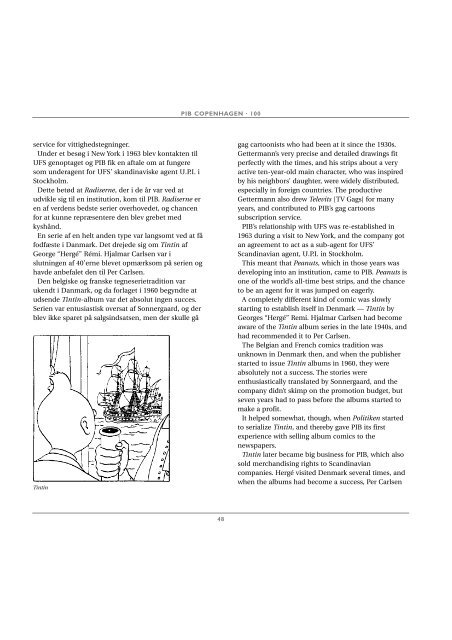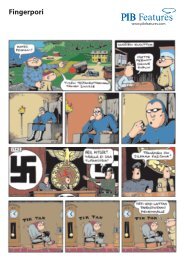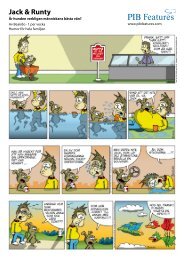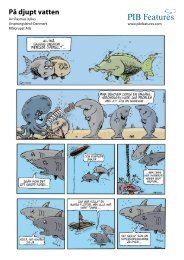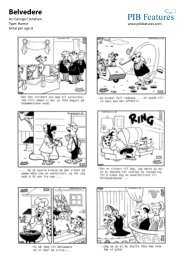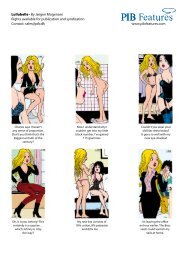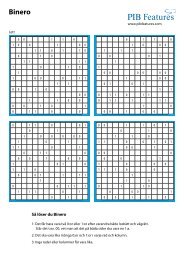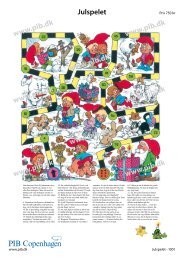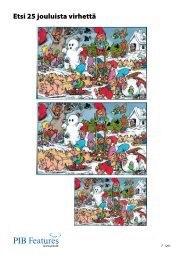PIB COPENHAGEN · 100 - PIB Copenhagen A/S
PIB COPENHAGEN · 100 - PIB Copenhagen A/S
PIB COPENHAGEN · 100 - PIB Copenhagen A/S
You also want an ePaper? Increase the reach of your titles
YUMPU automatically turns print PDFs into web optimized ePapers that Google loves.
service for vittighedstegninger.<br />
Under et besøg i New York i 1963 blev kontakten til<br />
UFS genoptaget og <strong>PIB</strong> fik en aftale om at fungere<br />
som underagent for UFS’ skandinaviske agent U.P.I. i<br />
Stockholm.<br />
Dette betød at Radiserne, der i de år var ved at<br />
udvikle sig til en institution, kom til <strong>PIB</strong>. Radiserne er<br />
en af verdens bedste serier overhovedet, og chancen<br />
for at kunne repræsentere den blev grebet med<br />
kyshånd.<br />
En serie af en helt anden type var langsomt ved at få<br />
fodfæste i Danmark. Det drejede sig om Tintin af<br />
George “Hergé” Rémi. Hjalmar Carlsen var i<br />
slutningen af 40’erne blevet opmærksom på serien og<br />
havde anbefalet den til Per Carlsen.<br />
Den belgiske og franske tegneserietradition var<br />
ukendt i Danmark, og da forlaget i 1960 begyndte at<br />
udsende Tintin-album var det absolut ingen succes.<br />
Serien var entusiastisk oversat af Sonnergaard, og der<br />
blev ikke sparet på salgsindsatsen, men der skulle gå<br />
Tintin<br />
<strong>PIB</strong> <strong>COPENHAGEN</strong> <strong>·</strong> <strong>100</strong><br />
48<br />
gag cartoonists who had been at it since the 1930s.<br />
Gettermann’s very precise and detailed drawings fit<br />
perfectly with the times, and his strips about a very<br />
active ten-year-old main character, who was inspired<br />
by his neighbors’ daughter, were widely distributed,<br />
especially in foreign countries. The productive<br />
Gettermann also drew Televits [TV Gags] for many<br />
years, and contributed to <strong>PIB</strong>’s gag cartoons<br />
subscription service.<br />
<strong>PIB</strong>’s relationship with UFS was re-established in<br />
1963 during a visit to New York, and the company got<br />
an agreement to act as a sub-agent for UFS’<br />
Scandinavian agent, U.P.I. in Stockholm.<br />
This meant that Peanuts, which in those years was<br />
developing into an institution, came to <strong>PIB</strong>. Peanuts is<br />
one of the world’s all-time best strips, and the chance<br />
to be an agent for it was jumped on eagerly.<br />
A completely different kind of comic was slowly<br />
starting to establish itself in Denmark — Tintin by<br />
Georges “Hergé” Remi. Hjalmar Carlsen had become<br />
aware of the Tintin album series in the late 1940s, and<br />
had recommended it to Per Carlsen.<br />
The Belgian and French comics tradition was<br />
unknown in Denmark then, and when the publisher<br />
started to issue Tintin albums in 1960, they were<br />
absolutely not a success. The stories were<br />
enthusiastically translated by Sonnergaard, and the<br />
company didn’t skimp on the promotion budget, but<br />
seven years had to pass before the albums started to<br />
make a profit.<br />
It helped somewhat, though, when Politiken started<br />
to serialize Tintin, and thereby gave <strong>PIB</strong> its first<br />
experience with selling album comics to the<br />
newspapers.<br />
Tintin later became big business for <strong>PIB</strong>, which also<br />
sold merchandising rights to Scandinavian<br />
companies. Hergé visited Denmark several times, and<br />
when the albums had become a success, Per Carlsen


